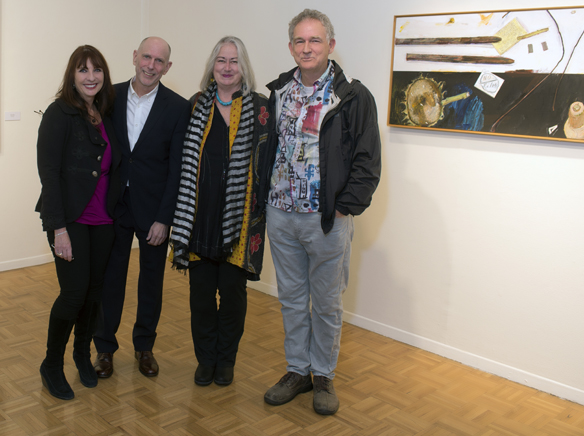An art exhibit on display through Thursday, Dec. 12, at Grossmont College’s Hyde Art Gallery explores how their mentors influence artists. Works of five artists are examined, including those of the late Manny Farber and Patricia Patterson, a husband-and-wife team who inspired the works and careers of the three other artists represented in the exhibit.
An art exhibit on display through Thursday, Dec. 12, at Grossmont College’s Hyde Art Gallery explores how their mentors influence artists. Works of five artists are examined, including those of the late Manny Farber and Patricia Patterson, a husband-and-wife team who inspired the works and careers of the three other artists represented in the exhibit.
The three “mentees,” who today are successful artists in their own right, are Bill Mosley, today an art instructor at Grossmont College, Leslie Nemour, who teaches art at Miracosta College, and Jim Randall, who is a practicing artist in New York City. All three took classes from Farber and Patterson when they were on the faculty at UCSD. Farber and Patterson taught that paintings and films could mutually influence each other, and the works of Mosley, Nemour and Randall, help to demonstrate that relationship.
For this, the late Manny Farber is chiefly responsible as he was both a painter and a movie critic, whose reviews were published regularly in such prestigious magazines as “New Republic,” “The Nation, Artforum” and “Art in America.” Farber’s reviews rarely dealt with the plots of the movies but rather focused on themes, movements, colors, and other aspects of the cinematographer’s art. He looked at films the way a painter would examine paintings and he studied paintings from the perspective of a filmmaker, said Mosley.
When Farber was 49 and already an established critic, he was introduced to Patterson, about whom the famed photographer Helen Leavitt wrote to him, “I met this young girl and I think the two of you would like each other.” Patterson was 25 at the time, but their age difference mattered little, so transported were the couple by each other’s art and outlooks on life. Very soon after meeting, they became married collaborators—she, of Irish background, whose paintings explored her ancestral country, and he the son of Jewish immigrants who had set down roots in Douglas, Arizona.
Growing up in the small town of Douglas, her husband had seen every movie that came to the two movie houses, Patterson said.
“He was born in 1917 so we are talking about very early film. He started out with the silent movies.” Farber also frequented the town’s library, “where he would study writing–how writing was done. He was a very, very hard worker.”
In the entry exhibit space of the Hyde Gallery are two large paintings by these mentors. A 26” by 40” still life by Farber entitled “No Film” and a 4’2 x 65” scene by Patterson which she titled “Patricia and Coidin,” after a couple who had been her hosts in Ireland. Patterson was an advocate of artists painting what was familiar to them, rather than forcing themselves to try to make some big statement.
As curated by Grossmont College’s Prudence Horne, the balance of the exhibit space in the gallery is devoted to the works of Mosley, Nemour and Randall. Each of these artists spoke about how film affects their painting. While their subjects are quite different, there are some similarities in how Mosley, Nemour and Randall go about their paintings. All three of them begin either with the images they find in movies or on still film. All three of them typically will draw or paint a small, test version of the work that they ultimately will create.
William Mosley
Mosley likes to paint different kinds of landscapes. Instead of those that view a scene from a horizontal perspective, as most people are used to seeing, his studies look down from the air toward the ground. At the gallery, a sequence of three large paintings gives us the sense of approaching, flying directly over, and departing from the airspace above the Interstate 805 freeway bridge as it crosses over Interstate 8 in Mission Valley.
Using the photos he took on a helicopter ride—along with images from Google Satellite photos—Mosley paints and repaints the scene, varying the perspective.
Leslie Nemour
Nemour had a dozen paintings on display in the gallery, all of them involving fistfights, wrestling matches or other types of physical violence. The images are intentionally blurred to give the sense that the depiction “is not forever, it is moving, it is changing and it is a moment in time,” she said.
The paintings are not a glorification of violence, but to the contrary are an effort to come to terms with it, she said.
“I am kind of making it into something else. I am making it symbolic of more contemporary kinds of fights, which are struggles for belief systems,” she said.
The fight scenes are intriguingly titled as battles over Feminism (the only one in which the subjects are women), Realism, Obama Care, Gay Marriage, Roe vs. Wade (abortion), Futurism and Cubism. A companion piece, “Fight Over Conceptual Art,” has a perplexed woman holding her face in her hands.
Jim Randall
Randall’s images are far more abstract, but they too start with photographs. He pointed to a large canvas covered in hues of red and orange. Initially, he said, he saw a newspaper photograph of a
fire. He magnified a section of the photograph until he had eliminated all that surrounded the flames, so that he could concentrate on the interior of the fire itself. And that, in abstract, was what he painted.
“Before, I was making things that were much more recognizable–the same material, the same source material, but I wasn’t happy with it,” he said. “So I decided to zoom in as if it were a movie and get more atmosphere into the painting.”
He also gets more physically active in executing the painting, using a string dipped in paint and then flogging the color onto the painting. He supplements this technique with brush strokes. He said he utilizes some very expensive materials, such as linen instead of canvas, rabbit skin glue/ resin, and a particular line of paints from Germany.
Randall zooms in like a movie to find the desired image; Nemour blurs movie images; and Mosley sequences his paintings as you might see them on a strip of movie film. The influence of cinema—and the love for the medium taught by Farber and Patterson—is manifest.














